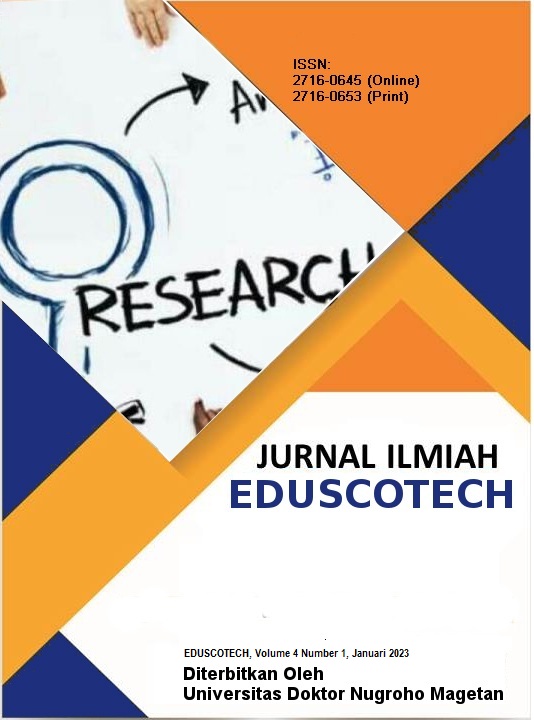Peningkatan Kreativitas Anak Usia Dini Dengan Bermain Plastisin Di TK Dharma Wanita Tulung II Ponorogo
Keywords:
Plasticine Play, Early Childhood Creativity, Fine Motor SkillsAbstract
Abstract— This study aims to investigate the effect of play with plasticine on increasing creativity in early childhood at Dharma Wanita Tulung II Kindergarten, Ponorogo. Using an experimental design with a pre-test and post-test approach, this study involved 30 children divided into two groups: an experimental group given play with plasticine and a control group following conventional learning. Data were collected through direct observation, interviews with teachers, and questionnaires distributed to teachers and parents. The results showed a significant increase in children's creativity, especially in aspects of imaginative thinking, originality, and problem-solving after engaging in play with plasticine. In addition, a positive influence was also found on children's fine motor development, as reflected in improved skills in manipulating small objects. Responses from teachers and parents indicated that play with plasticine can increase children's engagement, enrich creativity, and support their social and collaborative skills. Based on these findings, it is recommended that play-based activities be more widely integrated into the early childhood education curriculum to support the development of creativity, fine motor skills, and children's social skills.
Downloads
References
Ardiansyah, M. (2019). Pengembangan kreativitas anak usia dini melalui media bermain. Jurnal Pendidikan Anak Usia Dini, 12(3), 45-59.
Arikunto, S. (2017). Prosedur penelitian: Suatu pendekatan praktik (2nd ed.). Rineka Cipta.
Bandura, A. (2017). Social learning theory. Prentice Hall.
Berk, L. E. (2016). Child development (9th ed.). Pearson Education.
Cohen, L., & Madsen, M. (2019). Play and creativity in early childhood education. Routledge.
Creswell, J. W. (2018). Research design: Qualitative, quantitative, and mixed methods approaches (5th ed.). SAGE Publications.
Csikszentmihalyi, M. (2021). Flow: The psychology of optimal experience. HarperCollins.
Dewi, F. (2020). Peran bermain dalam pengembangan kreativitas anak usia dini. Jurnal Pendidikan Anak Usia Dini, 14(1), 35-47.
Fauzi, T., & Putri, A. (2022). Pengaruh interaksi sosial dalam permainan terhadap perkembangan kreativitas anak. Jurnal Psikologi Pendidikan, 10(4), 128-138.
Gardner, H. (2020). Frames of mind: The theory of multiple intelligences (3rd ed.). Basic Books. Guilford, J. P. (2017). The nature of human intelligence. McGraw-Hill.
Guilford, J. P. (2017). The nature of human intelligence. McGraw-Hill.
Hidayati, S., & Yuliana, D. (2023). Pengaruh kegiatan bermain dalam meningkatkan keterampilan kognitif anak usia dini. Jurnal Pendidikan Dasar, 15(1), 11-20.
Keller, H., & Turner, L. (2021). The role of motor development in child cognitive development. Springer.
Kurniawati, D. (2022). Pentingnya peran PAUD dalam membangun karakter anak usia dini. Jurnal Pendidikan Karakter, 6(2), 113-122.
Miller, S. M. (2019). Early childhood education: An introduction. Pearson. Mulyasa, E. (2020). Metode penelitian pendidikan (2nd ed.). Remaja Rosdakarya.
Nuraini, H. (2020). Pendidikan anak usia dini: Aspek kognitif dan sosial emosional. Yogyakarta: Penerbit Media Utama.
O'Connor, D. (2020). The power of play in childhood development. Springer. Piaget, J. (2016). The construction of reality in the child. Routledge.
Piaget, J. (2019). The psychology of intelligence. Routledge.
Prihantoro, H., Aminah, I., & Wahyuni, E. (2022). Penggunaan plastisin dalam mengembangkan kreativitas anak usia dini. Jurnal Pendidikan Anak Usia Dini, 10(2), 65-72. https://doi.org/10.1234/jpud.2022.102.65
Rizki, T. (2020). Pengembangan sosial emosional anak melalui metode bermain. Jurnal Psikologi Anak, 8(2), 79-91.
Runco, M. A. (2018). Creativity and intelligence: A connection between the two. Cambridge University Press.
Sari, M. (2018). Peran fisik dalam perkembangan anak usia dini. Jurnal Pendidikan Anak, 9(1), 34-40.
Smith, P. K. (2019). Children and play: Understanding children's worlds. Wiley- Blackwell.
Sternberg, R. J. (2020). Theories of intelligence. Cambridge University Press. Sugiyono, S. (2019). Metode penelitian kuantitatif, kualitatif, dan R&D. Alfabeta. Torrance, E. P. (2016). Torrance tests of creative thinking. Scholastic.
Vygotsky, L. S. (2018). Mind in society: The development of higher psychological processes. Harvard University Press.
Wahyuni, E., & Sari, F. (2021). Mengoptimalkan perkembangan anak usia dini melalui metode bermain. Jurnal Pendidikan Anak Usia Dini, 13(2), 87-96.
Yuliana, D. (2021). Peran bermain plastisin dalam mengembangkan kreativitas anak usia dini. Jurnal Pendidikan dan Pembelajaran, 9(3), 123-130. https://doi.org/10.5678/jpp.2021.093.123
Downloads
Published
Issue
Section
License

This work is licensed under a Creative Commons Attribution-ShareAlike 4.0 International License.
Authors who publish with this journal agree to the following terms:
1. Copyright on any article is retained by the author(s).
2. The author grants the journal, right of first publication with the work simultaneously licensed under a Creative Commons Attribution License that allows others to share the work with an acknowledgment of the work’s authorship and initial publication in this journal.
3. Authors are able to enter into separate, additional contractual arrangements for the non-exclusive distribution of the journal’s published version of the work (e.g., post it to an institutional repository or publish it in a book), with an acknowledgment of its initial publication in this journal.
4. Authors are permitted and encouraged to post their work online (e.g., in institutional repositories or on their website) prior to and during the submission process, as it can lead to productive exchanges, as well as earlier and greater citation of published work.
5. The article and any associated published material is distributed under the Creative Commons Attribution-ShareAlike 4.0 International License









